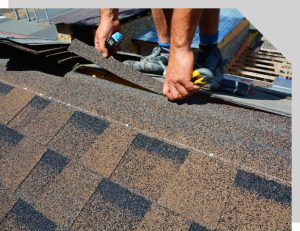Professional Roof Installation Near You
Imagine waking up one day to find your beautiful home’s interior soaked with water, leaving you feeling helpless and frustrated; all because of an old, failing roof! What if we told you that we can prevent this nightmare? Thunder Bay Roofing’s Edgewater roofing contractors have the tools and instructions needed for a successful professional roofing installation.
Say goodbye to leaks and hello to a sturdy new roof that will keep your home safe for years to come! Contact our roofing contractors near you at 410-956-7663 to get a free estimate and learn more about the cost of roof installation.
Hiring Your Professional Roofing Contractor
Installing a new roof is a big investment for any homeowner, so it’s important to make adequate preparations so that the process goes smoothly. The first and most crucial step in preparing for professional roof installation is to hire a professional roofing contractor, like those from Thunder Bay Roofing, who has experience with the type of roof you need.
Consultation
Once you have found your contractor, schedule a consultation to discuss the details. During this meeting, your Edgewater roofing contractor will survey the existing roof and inspect the decking to ensure that there are no underlying issues that could affect the new installation. They will also measure and determine the appropriate amount of material required to complete your roof.
Logistics
In addition to working with a good contractor, you’ll want to consider logistics before beginning the project. Secure all necessary building permits from your local building authority before work begins. Talk to your neighbors and let them know about your upcoming home renovation project — loud noise levels are expected during roofing projects, and notifying people around you can help avoid disturbances.
Set-Up
Another crucial aspect of preparing for professional roof installation is ensuring that surrounding objects are set up, or moved out of the way of possible damage or debris from the working area. They’ll place large tarps over plants and landscaping close to your home’s perimeter; these tarps will catch debris dislodged during removal or shingle placement and ensure they don’t affect the landscaping below.
Garbage cans should be adequately placed near the working area so the disposal process occurs continuously as opposed to having debris accumulate on top of each other. It may also be necessary to move vehicles off-site ahead of time, especially if they’re parked in front of or near your house. Clearing the driveway and parking area will ensure a safer work environment for everyone involved.
Removing the Old Roof
Before we begin with the professional roof installation, the old one must be removed. This is a crucial step to ensure that your new roofing materials will adhere correctly and ensure that any damaged or rotted decking is replaced. Proper removal of an old roof will also protect your property from further damage.
Stripping The Roof Clean
The next step is to strip the roof clean. Your Edgewater roof installers will remove all old nails or pound them flat with a hammer, so they don’t damage the new shingles during installation. They’ll remove all shingles down to the wood sheathing in four-foot sections to make it easier to handle and dispose of debris.
Tearing Off vs Re-Roofing
There are two primary methods for removing an old roof: tearing off (removing the old roof) or re-roofing over existing shingles. While re-roofing can be done faster and is less expensive than tearing off, it’s generally not recommended unless all local codes permit it, there are no more than two layers of pre-existing shingles on the roof surface, and there’s no rotting material underneath.
Laying the Foundation
Laying the new roof foundation is critical because it helps prevent leaks and makes sure your home can withstand extreme weather conditions like heavy rainstorms or snow accumulation.
Waterproofing and Sealing
The first step involves applying a waterproofing material and sealant. Before installing new roofing materials, it’s essential to create a waterproof barrier between the roof deck (the structural layer beneath the roofing materials) and the elements. Waterproofing materials and sealants protect the roof deck from water damage and prevent leaks. When properly applied, waterproofing materials can extend the life of your roof.
One common waterproofing material used by our Edgewater roofing contractors is self-adhesive waterproof underlayment. This product, also called an “ice barrier,” is typically applied along roof eaves to protect against ice dams that can form during cold weather. In areas with severe climates, this underlayment should be applied up to six feet from the eaves.
Sealants are another important component of a watertight roof system. Roofers use sealants to close gaps around vents, chimneys, and other protrusions in the roof. They also use them to seal joints between different roofing materials to prevent water infiltration.
Insulation Installation
Once the waterproofing is complete, they’ll proceed with insulation installation. Insulation plays a crucial role in protecting your home from extreme temperatures. Not only does it help to keep your home warm in the winter and cool in the summer, but it also serves as an effective sound barrier and fire retardant.
There are several types of insulation materials available, including:
- Fiberglass
- Cellulose
- Spray foam
- Mineral wool
Some homeowners may be tempted to skip having insulation altogether to save money on their new roof installation. However, a properly insulated roof can save you money on your energy bills over time and may even qualify you for tax incentives or rebates offered by government agencies or utility companies. Additionally, many building codes require a minimum level of insulation to meet energy efficiency standards. Failing to meet these requirements could result in fines or legal penalties for noncompliance.
installing New Roofing Materials
After removing the old roofing materials and properly preparing the foundation, they’ll install the new roofing materials. Choosing the right roofing material is key, but no matter what type of material you choose — whether it’s asphalt shingles, metal panels, or something else — a proper installation is crucial.
Roof Drip Edge and Underlayment
Your contractors will begin by installing roof drip edge along the eaves, followed by ice and water shield or tar paper underlayment for extra protection against moisture buildup. Once this has been done, they’ll begin laying out your chosen material according to manufacturer instructions. Our Edgewater roof installers stagger each course of shingles to prevent water penetration and follow manufacturer instructions regarding flashing around chimneys and vents.
Attaching Shingles or Metal Panels
Attaching shingles or metal panels is a critical part of the roofing installation process. After the new roofing materials have been laid out correctly along your rooftop, it’s time to secure them into place for long-lasting protection against the elements.
To attach shingles to your roof, your contractors will start by nailing down each shingle firmly onto the underlying strata and ensure that they are all properly aligned with manufacturer instructions. When installing metal panels, we may use a specialized metal cutting saw, which may be needed for precise cuts.
Final Steps and inspection
After all the roofing materials have been installed, there are still a few crucial steps to ensure that the roof is secure and durable. The roofers will inspect the new roof for any potential issues or areas that may cause problems in the future. This includes checking for loose shingles or panels, ensuring that all nails or screws are properly set, and looking for any gaps or spaces where water could penetrate.
Gutters and Downspouts
Another essential step in the installation process is installing rain gutters and downspouts. Without these elements, rainwater can accumulate at the base of the house, leading to water damage and other structural issues. We can place gutters along all sides of the roofline with downspouts directing water away from the foundation of your home.
Flashing 
After the final steps, they’ll conduct a thorough inspection of the new roof once it has been installed. This includes checking for proper flashing around chimneys, vents, skylights, and other protrusions on your roof. Your Edgewater roof contractors will also inspect the underlayment to ensure it was properly laid out underneath all roofing material pieces.
Additionally, they’ll check for proper drainage on your roof. Roof decks should slope slightly toward gutters or scuppers so that water does not pool on your roof as this may lead to leaks and damage in the future.
Flashing refers to the metal pieces that are installed over areas where your roof meets vertical walls or other sloping planes on your roof. The purpose of flashing is to direct water away from these vulnerable joints and prevent leaks. While it should be included throughout the installation process, there are several areas that require special attention after the roof has been installed.
Ventilation
Proper ventilation is also an important element of any professional roof installation. It ensures stability by protecting against temperature buildup in the attic space as well as mold growth by removing moisture.
To achieve proper ventilation, several different types of vents can be installed. Soffit vents are often used to bring air up into the attic space while ridge vents channel air out at the highest point of the roof. Other types of vents include gable vents, which are installed near the peak of a gabled roof.
It’s important to work with your roofing contractor to determine what type of ventilation system will work best for your home. Factors such as attic size, insulation, and the type of roofing material you choose can all impact the most effective type of vents.
A properly installed roofing system would eliminate the need for additional insulation. The type of ventilation system and insulation should be carefully planned and properly balanced to keep your home both energy-efficient and moisture-free.



